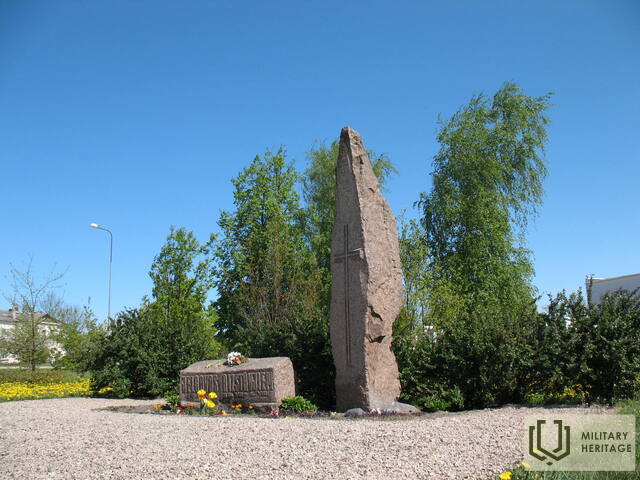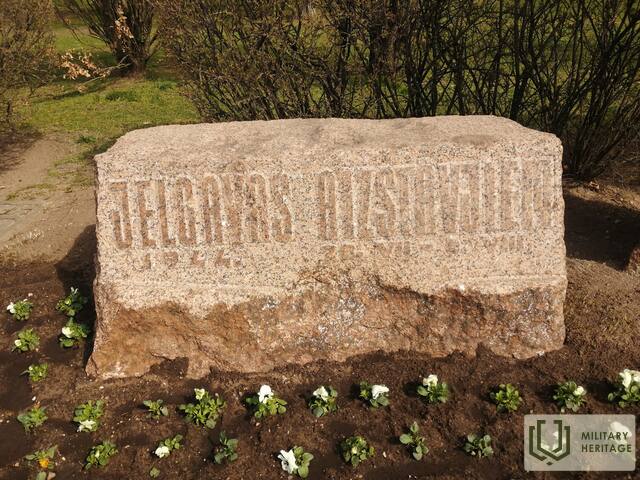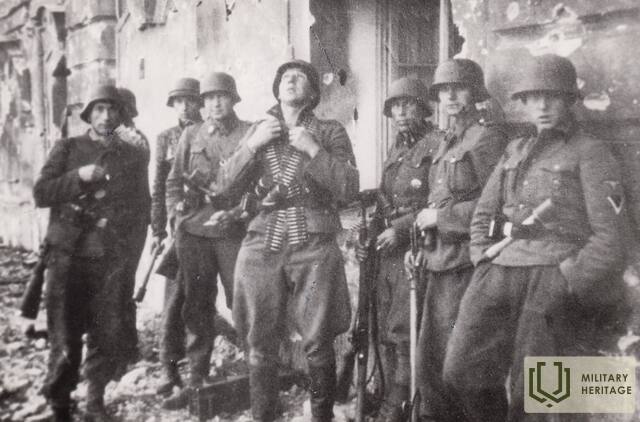Paminklas Jelgavos gynėjams nuo sovietų okupacijos 1944 m. Grėbnerio parke
Memorialinė vieta


 52
52



1995 m. gegužės 8 d. atidaryta atminimo vieta 1944 m. liepos–rugpjūčio mėn. vykusių Jelgavos gynybinių mūšių prieš antrąją sovietų okupaciją dalyviams. Šio įvykio garbei vyko pamaldos Jelgavos Šv. Onos evangelikų liuteronų bažnyčioje ir vėliavomis išpuošta procesija per Jelgavą. Atminimo vietoje stovi netaisyklingos formos granito stela, kurioje iškaltas kryžius, įaugantis į kalavijo smaigalį. Šalia, kairėje, žuvėdros pavidalu išdėstytas nupjauto gretasienio formos granito luitas su užrašu „Jelgavos gynėjams 1944.28.VII-8.VIII“.
Karas Jelgavoje prasidėjo po to, kai 1944 m. liepos 27 d. sovietų kariuomenė užėmė Šiaulius Lietuvoje ir tęsė puolimą šiaurės kryptimi. Siekdamas atremti Raudonosios armijos puolimą, naujai paskirtas Jelgavos karinis vadas generolas leitenantas Johanas Flugbeilis paskelbė miestą „tvirtove“ ir visos turimos pajėgos turėjo būti panaudotos miesto gynybai. Iš pradžių Jelgavos gynėjų branduolį sudarė tik 15-osios Latvijos SS ginklų divizijos mokymo ir rezervo brigados, vadovaujamos pulkininko leitenanto Hermano Jurko, kariai ir keli nedideli vokiečių daliniai. Liepos 27 d. popietę sovietų 3-ioji oro armija pradėjo bombarduoti Jelgavą, atakuodama ne tik strateginius karinius taikinius mieste ir jo apylinkėse – geležinkelio stotį ir kelius, – bet ir padegdama kai kuriuos gyvenamuosius pastatus. Miesto pastatai ir civiliai nukentėjo nuo „Katiušos“ raketų sistemų, artilerijos ir minosvaidžių ugnies, kurią viena į kitą apšaudė abi kariaujančios pusės.
Liepos 28 d. sovietų 3-iojo gvardijos mechanizuotojo korpuso daliniai pradėjo puolimą miesto pietiniame pakraštyje, tačiau nesėkmingai. Liepos 30 d. rytą puolimą sustiprino 51-osios armijos 279-oji ir 347-oji šaulių divizijos. Nors Maskvos radijas kitą dieną pranešė apie miesto užėmimą, SSRS kariuomenei su pastiprinimu pavyko įsiveržti į miesto centrą, bet ne visiškai jo užimti. Dešinysis Lielupės upės krantas ir įtvirtintas tilto galas prie Driksos tilto liko Raudonosios armijos neužimti. Įnirtingos kovos vyko ir Jelgavos pilyje, kuri rugpjūčio pradžioje perėjo sovietų kontrolei. Raudonoji armija perkėlė į pilį patrankas ir iš jos langų apšaudė vokiečių ir latvių kareivių pozicijas Kalnciemo kelyje. Po to sekė vokiečių sunkiosios artilerijos kontruguotė, kuri visiškai sunaikino pilį. Rugpjūčio 4 d., gavę pastiprinimą iš Rygos, Jelgavos gynėjams pavyko laikinai perimti miesto kontrolę. Tačiau masinis sovietų puolimas privertė vokiečių ir latvių kareivius po trijų dienų palikti Jelgavą.
Panaudoti šaltiniai ir literatūra:
J. Blīvis. Mūšiai už Jelgavos gynybą 1944 m. // Latvijos kareivis Antrojo pasaulinio karo metu. 11 tomas. Torontas: Dauguvos Vanagu centrinė valdyba, 1993, p. 187–230.
U. Neiburgas. Mūšiai dėl Jelgavos. Žiemgalos metropolio sunaikinimas 1944 m. liepos 28-31 d. // Mājas Viesis, 2015, liepos 3-16 d. https://www.la.lv/kavi-par-jelgavuzemgales-metropoles-bojaeja-1944-gada-28-31-julija/galerija/setupad
V. Kuzminas. Tankų generolų mūšis Žiemgaloje. 1944 m. liepa–rugpjūtis // Iliustruota pasaulio istorija, 2017, Nr. 8 (rugpjūtis), p. 16–24.
https://karavirukapi.blogspot.com/2021/01/jelgava-piemineklis-latviesu-karaviriem.html








